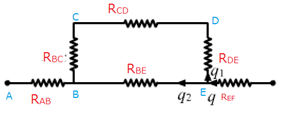Consider the situation shown in figure. The frame is made of the same material and has a uniform cross-sectional are everywhere. Calculate the amount of heat flowing per second through a cross-section of the bent part if the total heat taken out per second from the end at 100°C is 130J.

For the above frame, redrawing the fig,

(1)
The equivalent resistance network becomes –
Let RAB, RBC, RCD, RDE, REF and RBE be the equivalent resistance across each cross-section as shown in fig. below –

(2)
Resistance in terms of conductivity
R= ![]() (1)
(1)
From fig (1) and (2)and equation (1)
RAB = ![]() , RBC =
, RBC =![]() , RCD =
, RCD =![]() , RDE =
, RDE =![]() , REF=
, REF=![]() and RBE =
and RBE =![]()
Now, lets reduce the network into equivalent network .
Since RBC RCD RDE are connected in series, let R1 be their equivalent resistance.
Then R1 = RBC+RCD + RDE
= ![]()
= ![]()
Now the circuit reduces to –

Now from Kirchhoff’s current law(KCL), we know The algebraic sum of all currents entering and exiting a node must equal zero
Hence ,KCL at point E , since ![]() -
-
q = q1 +q2
Now, since R1 and RBE are in parallel, so total heat across R1 and RBE will be same.
ie, q1R1 = q2RBE
⇒ ![]() =
= ![]()
⇒ q2 = ![]()
Now, q = q1 +q2
= q1 +![]() q1
q1
Given q = 130 J, substituting above
130 = ![]()
⇒ q1 = 60 J